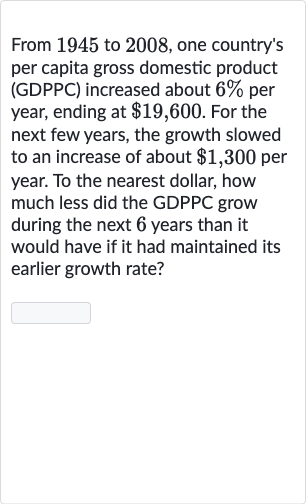AI tutor
Welcome to Bytelearn!
Let’s check out your problem:

From to , one country's per capita gross domestic product (GDPPC) increased about per year, ending at . For the next few years, the growth slowed to an increase of about per year. To the nearest dollar, how much less did the GDPPC grow during the next years than it would have if it had maintained its earlier growth rate?
Full solution
Q. From to , one country's per capita gross domestic product (GDPPC) increased about per year, ending at . For the next few years, the growth slowed to an increase of about per year. To the nearest dollar, how much less did the GDPPC grow during the next years than it would have if it had maintained its earlier growth rate?
- Calculate GDPPC growth: Calculate the GDPPC growth for the next years at the earlier growth rate of per year.The formula for exponential growth is , where is the initial amount, is the growth rate, and is the time in years., or , and years.
- Perform calculation for earlier growth rate: Perform the calculation for the earlier growth rate.
- Calculate GDPPC growth at slowed rate: Calculate the GDPPC growth for the next years at the slowed growth rate of per year.The linear growth is calculated by adding the annual increase to the initial amount for each year.
- Calculate difference in GDPPC growth: Calculate the difference in GDPPC growth between the earlier growth rate and the slowed growth rate.Difference = GDPPC at earlier growth rate - GDPPC at slowed growth rateDifference = - Difference
More problems from Understanding integers
QuestionGet tutor help
QuestionGet tutor help
QuestionGet tutor help
QuestionGet tutor help
QuestionGet tutor help
QuestionGet tutor help
QuestionGet tutor help
QuestionGet tutor help
QuestionGet tutor help
